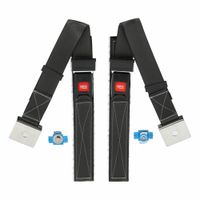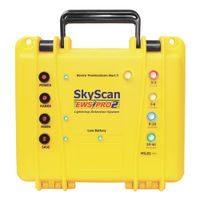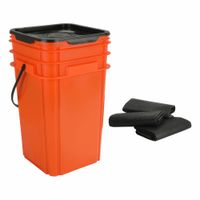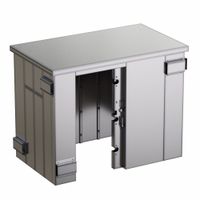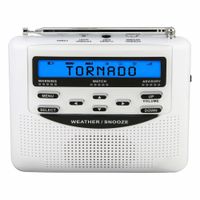Call +(254) 703 030 000 / 751 483 999 / 721 704 777
- Home
- Safety
- Emergency Preparedness Products
- Weather Natural Disaster Preparedness
.....Read More
Frequently Asked Questions
What supplies are essential for earthquake preparedness?
Essential supplies for earthquake preparedness include:
1. **Water**: Store at least one gallon per person per day for a minimum of three days for drinking and sanitation.
2. **Food**: Keep a three-day supply of non-perishable food items such as canned goods, energy bars, and dried fruits.
3. **First Aid Kit**: Include bandages, antiseptics, pain relievers, and any necessary prescription medications.
4. **Flashlights and Batteries**: Have multiple flashlights with extra batteries to ensure visibility if power is lost.
5. **Radio**: A battery-powered or hand-crank radio to receive emergency updates and information.
6. **Multi-tool or Swiss Army Knife**: Useful for a variety of tasks, from opening cans to minor repairs.
7. **Whistle**: To signal for help if trapped.
8. **Dust Masks**: Protects against dust and debris in the air.
9. **Plastic Sheeting and Duct Tape**: For temporary shelter or to seal off areas.
10. **Moist Towelettes, Garbage Bags, and Plastic Ties**: For personal sanitation.
11. **Local Maps**: In case GPS is unavailable, maps can help navigate to safety or locate resources.
12. **Cell Phone with Chargers and Backup Batteries**: For communication and accessing information.
13. **Cash**: Small bills and coins, as ATMs and card readers may be inoperable.
14. **Sturdy Shoes and Gloves**: Protect against debris and sharp objects.
15. **Blankets or Sleeping Bags**: To keep warm if displaced from your home.
16. **Important Documents**: Copies of identification, insurance policies, and medical records in a waterproof container.
17. **Emergency Contact Information**: A list of family and emergency contacts.
18. **Special Needs Items**: Supplies for infants, elderly, or disabled family members, such as diapers, formula, or mobility aids.
19. **Pet Supplies**: Food, water, and other necessities for pets.
20. **Fire Extinguisher**: To address small fires that may occur.
How do weather radios work and why are they important?
Weather radios operate by receiving broadcasts from the National Oceanic and Atmospheric Administration (NOAA) Weather Radio All Hazards (NWR) network. These broadcasts are transmitted on a dedicated frequency band, separate from AM/FM radio, and provide continuous updates on weather conditions, forecasts, and emergency alerts. The radios are equipped with a Specific Area Message Encoding (SAME) technology, which allows them to be programmed to receive alerts specific to certain geographic areas, ensuring that users receive relevant information.
The importance of weather radios lies in their ability to provide timely and accurate information during severe weather events and emergencies. Unlike television or internet services, which can be disrupted during storms, weather radios are designed to function independently of these systems, often with battery backup, ensuring they remain operational during power outages. This reliability is crucial for early warnings about tornadoes, hurricanes, floods, and other hazardous conditions, allowing individuals and communities to take necessary precautions to protect life and property.
Moreover, weather radios are not limited to weather-related alerts; they also broadcast information about other emergencies, such as chemical spills, AMBER alerts, and national security threats. This makes them a versatile tool for public safety. By providing real-time alerts and instructions, weather radios play a critical role in disaster preparedness and response, helping to mitigate the impact of natural and man-made disasters.
What is the best way to secure furniture for earthquake safety?
To secure furniture for earthquake safety, start by anchoring heavy items like bookshelves, cabinets, and dressers to the wall using L-brackets, safety straps, or furniture anchors. Ensure that the anchors are attached to wall studs for maximum stability. Use flexible fasteners for items that may need to move slightly during an earthquake.
For televisions and electronics, use safety straps or anti-tip devices to secure them to the wall or furniture. Place heavy items on lower shelves to prevent them from falling and causing injury. Use museum putty or gel to secure smaller items like vases, picture frames, and collectibles to shelves.
In the kitchen, install safety latches on cabinet doors to prevent them from swinging open and spilling contents. Secure large appliances like refrigerators and ovens with appliance straps. For hanging items such as mirrors and artwork, use closed hooks or earthquake hooks that prevent them from falling off the wall.
Consider rearranging furniture to avoid placing heavy items near beds or seating areas where they could fall and cause injury. Ensure that exit paths are clear of obstacles that could block escape routes during an earthquake.
Regularly inspect and maintain all safety devices and anchors to ensure they remain effective over time. Educate family members about earthquake safety measures and conduct regular drills to ensure everyone knows what to do during an earthquake.
By taking these precautions, you can significantly reduce the risk of injury and damage during an earthquake, ensuring a safer environment for you and your family.
How do lightning detectors help during thunderstorms?
Lightning detectors play a crucial role in enhancing safety and preparedness during thunderstorms. These devices detect and monitor lightning activity by sensing the electromagnetic pulses emitted by lightning strikes. By providing real-time data on the location, frequency, and intensity of lightning, they help in several ways:
1. **Early Warning**: Lightning detectors offer early warnings by identifying the presence of lightning activity in a specific area. This allows individuals and organizations to take precautionary measures to protect life and property.
2. **Safety Measures**: With accurate information on lightning proximity, outdoor activities can be halted, and people can seek shelter. This is particularly important for events, sports, and construction sites where large groups are exposed.
3. **Aviation Safety**: Lightning detectors are vital for aviation, helping pilots and air traffic controllers avoid stormy areas, ensuring safer flight paths and reducing the risk of lightning-related incidents.
4. **Power Grid Protection**: Utility companies use lightning detection to protect power grids. By knowing where lightning is likely to strike, they can prevent outages and damage to infrastructure by rerouting power or shutting down vulnerable sections.
5. **Data Collection and Analysis**: These detectors contribute to meteorological research by providing data that helps in understanding storm patterns and improving weather forecasting models.
6. **Insurance and Risk Management**: Insurance companies use lightning data to assess risk and manage claims related to lightning damage, leading to more accurate policy pricing and risk assessment.
Overall, lightning detectors are essential tools for mitigating the risks associated with thunderstorms, enhancing public safety, and minimizing economic losses.
What features should a tornado or storm shelter have?
A tornado or storm shelter should have several critical features to ensure safety and functionality:
1. **Structural Integrity**: The shelter must be built to withstand high winds and flying debris. It should comply with FEMA guidelines or ICC-500 standards, using reinforced concrete, steel, or other robust materials.
2. **Location**: Ideally, the shelter should be underground or in an interior room on the lowest floor of a building. It should be easily accessible from the main living areas.
3. **Size and Capacity**: The shelter should be large enough to accommodate all household members comfortably, with a minimum of 5 square feet per person.
4. **Ventilation**: Adequate ventilation is crucial to prevent suffocation. The shelter should have vents that allow airflow but are designed to prevent debris from entering.
5. **Door and Entry**: The door should be inward-opening, impact-resistant, and securely anchored. It should have a reliable locking mechanism to prevent it from being blown open.
6. **Emergency Supplies**: The shelter should be stocked with essentials like water, non-perishable food, a first-aid kit, flashlights, batteries, a weather radio, and blankets.
7. **Communication**: A battery-powered or hand-crank radio is essential for receiving weather updates. A charged mobile phone or a two-way radio can be useful for communication.
8. **Lighting**: Battery-operated or solar-powered lights should be available in case of power outages.
9. **Sanitation**: Basic sanitation supplies, such as a portable toilet or sanitation bags, should be included.
10. **Identification and Signage**: The shelter should be clearly marked, and all household members should be familiar with its location and operation.
11. **Accessibility**: Ensure the shelter is accessible to all family members, including those with mobility issues.
12. **Maintenance**: Regular inspections and maintenance are necessary to ensure the shelter remains in good condition and ready for use.
How can sandbags be effectively used for flood control?
Sandbags are a traditional and effective method for flood control when used correctly. To maximize their effectiveness, follow these steps:
1. **Material Selection**: Use burlap or polypropylene bags, as they are durable and can hold sand effectively. Ensure bags are filled halfway to two-thirds full with sand or soil, allowing them to mold into place.
2. **Placement**: Begin by laying a plastic sheet or tarp on the ground to act as a moisture barrier. Place the first row of sandbags parallel to the anticipated water flow, ensuring they are tightly packed and overlap each other like bricks in a wall.
3. **Layering**: Build the wall in a pyramid shape for stability. Each subsequent layer should be staggered, with bags placed perpendicular to the layer below. This interlocking pattern helps distribute pressure and prevents gaps.
4. **Height and Width**: The wall should be at least one foot higher than the expected water level. The base should be three times as wide as the height to ensure stability.
5. **Sealing**: To prevent water seepage, tamp down each layer and fill any gaps with loose sand. The top layer should be covered with a plastic sheet, secured with additional sandbags, to repel water.
6. **Maintenance**: Regularly inspect the sandbag wall for signs of wear or displacement, especially during prolonged flooding. Replace damaged bags and reinforce weak spots promptly.
7. **Disposal**: After the flood, dispose of sandbags properly, as they may be contaminated with pollutants. Follow local guidelines for disposal or reuse.
By following these guidelines, sandbags can effectively divert water, protect structures, and minimize flood damage.
What are the most important items to include in a natural disaster emergency kit?
1. **Water**: At least one gallon per person per day for a minimum of three days for drinking and sanitation.
2. **Food**: Non-perishable items such as canned goods, protein bars, and dried fruits for at least three days.
3. **Manual Can Opener**: Essential for opening canned food if the power is out.
4. **First Aid Kit**: Include bandages, antiseptic wipes, pain relievers, and any prescription medications.
5. **Flashlight**: Battery-powered or hand-crank, with extra batteries.
6. **Radio**: Battery-powered or hand-crank to receive emergency updates.
7. **Batteries**: Extra sets for all battery-operated devices.
8. **Multi-tool**: Useful for a variety of tasks, from opening packages to minor repairs.
9. **Whistle**: For signaling for help if trapped or lost.
10. **Dust Masks**: To help filter contaminated air.
11. **Plastic Sheeting and Duct Tape**: For creating a makeshift shelter or sealing off a room.
12. **Moist Towelettes, Garbage Bags, and Plastic Ties**: For personal sanitation.
13. **Local Maps**: In case GPS is unavailable.
14. **Cell Phone with Chargers and Backup Battery**: For communication and information.
15. **Cash**: Small bills and coins, as ATMs may not be operational.
16. **Important Documents**: Copies of identification, insurance policies, and medical records in a waterproof container.
17. **Clothing and Blankets**: Warm clothing, sturdy shoes, and blankets or sleeping bags.
18. **Personal Hygiene Items**: Toothbrush, toothpaste, and other essentials.
19. **Infant Supplies**: If applicable, include formula, diapers, and bottles.
20. **Pet Supplies**: Food, water, and other necessities for pets.
21. **Emergency Contact Information**: Written list of family and emergency contacts.
